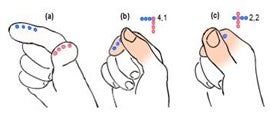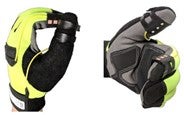Background
There is a need for creating wearable input devices that minimize movement for comfort and social acceptability. Using small finger movements is perhaps the most subtle style of input but can be challenging to reliably sense. Methods like mounting a camera on or near the hand, using sensors on a smartwatch, or magnetic field sensing can track continuous movements of fingers, but all are limited by accuracy, bulk, and power demands.
Description of the invention
Tip-Tap is an interaction technique and related RFID-based sensing method that simplifies finger input to a discrete set of input events. The technique creates an addressable matrix of discrete input events by detecting different pinch points at the intersection of two arrays of contacts, mounted near the tips of the index finger and thumb (Figure 1). A novel RFID tag design featuring two half-antennas and multiple RFID chips (Figure 2) enables detecting touch events. A glove embodiment of Tip-Tap (Figure 2 (a)) can communicate simple input commands with a range of up to 7 meters.
Advantages
The device/method is robust, small, simple, and “battery-free” (no power source is attached to the wearable device). It can also provide different types of passive haptic feedback.
Potential applications
Tip-Tap embodiments in gloves or on-skin tattoos are useful for issuing simple commands where:
- a user cannot easily hold an input device and the usage context is a defined area. For example, factory workers, surgeons, or people exercising in a gym.
- Interaction with small device form factors (eg. wearables, smart watch, auto infotainment systems, etc)
- a user would like to provide an input without unnecessarily touching certain surfaces such as elevator keys, medical equipment panels retail POSE terminals, etc. in a pandemic situation similar to COVID-19.

Figure 1. Tip-Tap showing 4x4 example:
(a) arrays of discrete contact points along the index and thumb tips; (b and c) pressing thumb to index creates 16 different 2D inputs
(a)

(b)

Figure 2. RFID Tip-Tap device (a) on a glove (b) as an on-skin tattoo
Reference
10181
Patent status
US Patent 11,397,864
Stage of development
Prototype developed
Ongoing research
Contact
Scott Inwood
Director of Commercialization
Waterloo Commercialization Office
519-888-4567, ext. 43728
sinwood@uwaterloo.ca
uwaterloo.ca/research